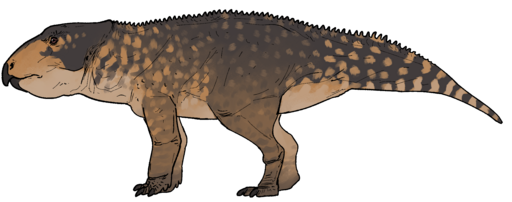According to the Natural History Museum, there are 37 dinosaur species found in Canada. This includes a newly discovered hornless dinosaur, which was related to Triceratops.

Late Cretaceous Hornless Dinosaur
While exploring the sediments of the Oldman Formation in southern Alberta in Canada, a team of paleontologists discovered the fossilized frontal bone of a new dinosaur species. The ancient beast was assumed to have measured approximately 6.6 feet (2 meters) long.
Named Gremlin slobodorum, the previously unknown species lived more than 70 million years ago during the Campanian age of the Late Cretaceous epoch. It was named after the diminutive creatures of film and folklore.
The species is classified as a leptoceratopsid dinosaur, a family of hornless, parrot-beaked herbivorous dinosaurs. The four-footed plant-eater also used its beak-like snout to look for food in low-growing vegetation. Gremlin slobodorum differed from Triceratops and other ceratopsids because they lacked horns on their faces and only possessed a small frill that extended from behind their head.
The newly-found dinosaur lies intermediate in age between two leptoceratopsids: Unescoceratops from the Dinosaur Park Formation and the Geryphoceratops from the Milk River Formation. Because of this, the discovery of Gremlin slobodorum fills a gap in Alberta's fossil record of leptoceratopsid dinosaurs.
Its description and comparison to other leptoceratopsids enabled the researchers to reevaluate the characteristics of paired frontal bones of the skull roof, which were previously considered significant for classification. Furthermore, identifying the new species helps them better understand the evolution of leptoceratopsids in the region by narrowing the temporal gap between the oldest known leptoceratopsid and the one that sits stratigraphically above it.
What are Leptoceratops?
Leptoceratops refers to the members of a genus of leptoceratopsid ceratopsian dinosaurs living in Asia, Europe, and North America. Its name means 'thin-horned face' and was derived from the Greek words 'small,' 'insignificant,' 'slender,' 'lean,' and 'horn.' Unlike the more famous ceratopsid ceratopsians, leptoceratops were smaller, mainly around the size of sheep, according to dinosaur paleontologist Michael Ryan from Carleton University.
The Leptoceratopsidae was originally named in 1923 by Hungarian paleontologist Franz Nopsa von Fels-Silves as the sub-family Leptoceratopsinae, whose type species is Leptoceratops gracilis. In 2001, it was defined as a stem-based taxon and a family composed of all species closer to Leptoceratops than Leptoceratops gracilis and Triceratops phoridus.
Despite the name, members of Leptoceratopsidae did not have horned faces. Their relatively small size also prevented them from being eaten by their much larger cousins. Another distinguishing feature of this species is their massive, robust lower jaws with large, bulbous teeth. In comparison, ceratopsids had shallow jaws with slender double-rooted teeth.
The difference in dentition and jaw structures suggests that these two families preferred different vegetation types, which allowed them to flourish side by side almost exclusively in Asia and North America. Meanwhile, an unnamed species found in Sweden may represent the first and only leptoceratopsid member from Europe.
RELATED ARTICLE : New Herbivorous Dinosaur Unearthed in Chile Challenges Geographic Range of Duck-Billed Species
Check out more news and information on Herbivorous Dinosaur in Science Times.
© 2026 ScienceTimes.com All rights reserved. Do not reproduce without permission. The window to the world of Science Times.










